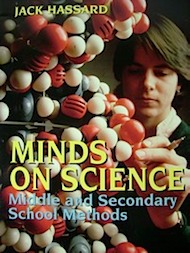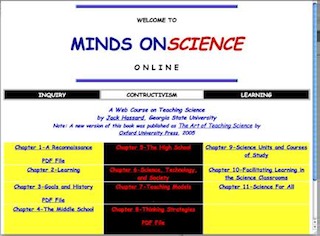In 1989, in midst of the work on alternative science teacher education, and the development of the Global Thinking Project a seed was planted by a publisher asking if I might be interested in writing a science methods books for secondary teacher education. I had thought about it long ago, and now I felt that I had the experiences that might give the book a different kind of foundation than other books in the field. I wrote an outline (shown in the Table of Contents) and developed several chapters for the book.
In 1990, at a conference in Atlanta, I had a chance meeting with Chris Jennison, the education publisher of HarperCollins, and publisher of several of my books with Goodyear Publishing. When I told him of my project for a book for secondary science, he offered me a contract, and funds to pay Dr. Dvorah Naveh to provide annotated resources for each chapter of the book, and for the Appendix.
Jennison asked me what I wanted to title the book, and at the time, I didn’t have an idea. A few months later the title emerged: Minds on Science: Middle and Secondary School Methods. I went ahead and completed the book, and submitted the manuscript. Months later, after I reviewed the type set pages, I sent a message to Chis suggesting that the subtitle be changed to The Art of Teaching Science, instead of Middle and Secondary School Methods. The suggestion arrived at the publisher too late, and when I saw the first copy of the book, I was sorry to see that the phrase “art of teaching science” had not been part of the title. But, things simply don’t always happen the way you plan it. Minds on Science was published in 1992, and 13 years later, I would be able to use the phrase “art of teaching science” in the sequel to Minds on Science. But that’s getting ahead of the story.
Minds on Science took a pathway different than most of the other secondary science textbooks. For the book, I developed a number of "pedagogical learning tools" that were woven throughout the text.
- Inquiry Activities: Integrated
with the text, these twenty-eight science teaching investigations enable students
to reflect on the important concepts of science teaching using hands-on and
minds-on strategies.
- Think Pieces: These are short
essays or posters that reflect students’ views on a topic or subject in
science teaching.
- Case Studies: Brief case study
scenarios are presented in order to engage students in reflective thinking,
role playing, and discussion on science teaching.
- Science Teachers Talk: These
are craft-talk interviews with several practicing science teachers
providing thoughtful and compelling ideas about teaching.
- Research Matters: Consumer
type reports of research from NARST on various topics.
- Science Teaching Literature:
Brief essays and articles from journals in science education.
- Problems and Extensions: Hands
on and minds on problems designed to engage students in problem solving
activities.
- Reflective Teaching: A
laboratory encounter with teaching in which students present lessons and
develop a reflective approach to science teaching.
- Microteaching: A scaled down
version of teaching in which students plan lessons based on one of the
models of teaching presented in Minds on Science.
Minds on Science was a text used by colleagues for several years. I used the text in the TEEMS program, which is explored in the next section.
Although a second edition
of Minds on Science was never written, I did put the entire book up on a website, and made it
available to professors after the text ceased to be printed and available.

